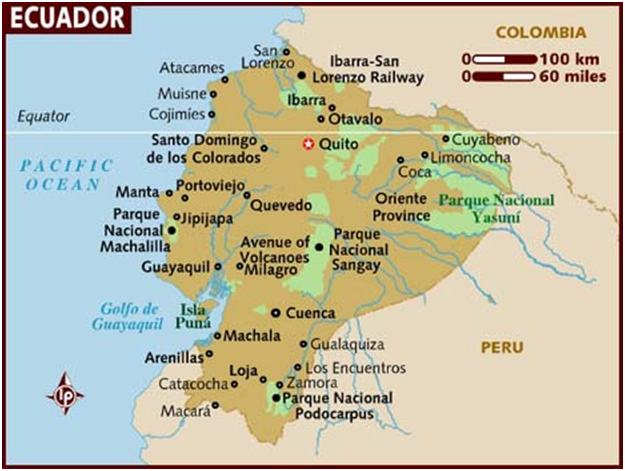| ECUADOR |
 |
|
Formal
name in Spanish: Repblica del
Ecuador
Capital: Quito
Head of government: President Rafael CORREA Delgado
Languages: Spanish
Surface area: 256,370 km2
Population: 15,439,429 (2013 est.)
Labour force:6.779 million (2012 est)
Currency: US Dollar
GDP: US$134.7 billion (2012 est.)
GDP per Capital: US$8,800 (2012)
GDP Growth Rate:
4% (2012 est.)
Inflation: 5.3% (2012 est.)
Main economic sectors:
Services (57.5%), Industry (36.1%) , Agriculture
(6.4%)
Main export commodities: petroleum, bananas, cut flowers, shrimp, cacao, coffee, wood, fish
Value of Exports:
US$23.77 billion (2012 est.)
Export partners: USA, Panama, Peru
Largest companies (take from top 500 ranking):
SUPERMERCADOS LA FAVORITA, CONECEL
Top business schools: IDE(GUAYAQUIL),
ESPAEESPOL(GUAYAQUIL)
Poverty (% living on <US$2/day):
27.3% (2012 est.)
Education (% of young people in higher education):
35%
Human development index:
0.724 (72ND)
Energy consumption (Quadrillion Btu):0.289
Energy production (Quadrillion Btu):0.014
Sources of energy: oil
(80%), hydropower (17%), natural gas (3%)
(Source: CIA, The World Factbook) |
|
|
|

| COUNTRY
BRIEF |
Ecuador is substantially dependent on its petroleum resources, which have accounted for more than half of the country's export earnings and approximately two-fifths of public sector revenues in recent years. In 1999/2000, Ecuador's economy suffered from a banking crisis, with GDP contracting by 5.3% and poverty increasing significantly. In March 2000, the Congress approved a series of structural reforms that also provided for the adoption of the US dollar as legal tender. Dollarization stabilized the economy, and positive growth returned in the years that followed, helped by high oil prices, remittances, and increased non-traditional exports. From 2002-06 the economy grew an average of 4.3% per year, the highest five-year average in 25 years. After moderate growth in 2007, the economy reached a growth rate of 6.4% in 2008, buoyed by high global petroleum prices and increased public sector investment. President Rafael CORREA, who took office in January 2007, defaulted in December 2008 on Ecuador's sovereign debt, which, with a total face value of approximately US$3.2 billion, represented about 30% of Ecuador's public external debt. In May 2009, Ecuador bought back 91% of its "defaulted" bonds via an international reverse auction. Economic policies under the CORREA administration - for example, an announcement in late 2009 of its intention to terminate 13 bilateral investment treaties, including one with the United States - have generated economic uncertainty and discouraged private investment. The Ecuadorian economy slowed to 1% growth in 2009 due to the global financial crisis and to the sharp decline in world oil prices and remittance flows. Growth picked up to a 3.3% rate in 2010 and nearly 8% in 2011, before falling to 4% in 2012. China has become Ecuador's largest foreign lender since Quito defaulted in 2008, allowing the government to maintain a high rate of social spending; Ecuador contracted with the Chinese government for more than $9 billion in oil for cash and project loans as of December 2012.
(Source: CIA, the World Factbook) |
|










